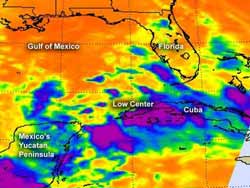NASA eyeing southern Gulf of Mexico low for tropical trouble

NASA's Aqua satellite AIRS instrument captured this infrared image of a low in the southern Gulf of Mexico on June 21 at 3:29 a.m. EDT. The strongest thunderstorms (purple) have high, cold cloud tops (of -63F/-52C)located southwest and southeast of the center. Credit: NASA/JPL, Ed Olsen<br>
Infrared data from the Atmospheric Infrared Sounder (AIRS) instrument that flies onboard NASA's Aqua satellite is helping forecasters at the National Hurricane Center understand what's happening with the low pressure area.
In an image captured on June 21 at 0729 (3:29 a.m. EDT), the center of the low pressure area appears to be near the western tip of Cuba near 22 North and 85 West. The strongest thunderstorms and convection (rising air that forms the thunderstorms) have high, cold cloud tops (of -63F/-52C) that indicate strong uplift, southwest and southeast of the center.
The National Hurricane Center noted that the large area of clouds, showers and thunderstorms extend from the northwestern Caribbean Sea north into the southeastern Gulf of Mexico and over Florida.
There are currently strong upper level winds that have been inhibiting development, but those winds are expected to weaken, giving the low more of a chance to get organized. The low continues to move north into the Gulf of Mexico bringning heavy rainfall and possible flooding over Mexico's Yucatan Peninsula, western Cuba and southern Florida over the next couple of days.
Media Contact
More Information:
http://www.nasa.govAll latest news from the category: Earth Sciences
Earth Sciences (also referred to as Geosciences), which deals with basic issues surrounding our planet, plays a vital role in the area of energy and raw materials supply.
Earth Sciences comprises subjects such as geology, geography, geological informatics, paleontology, mineralogy, petrography, crystallography, geophysics, geodesy, glaciology, cartography, photogrammetry, meteorology and seismology, early-warning systems, earthquake research and polar research.
Newest articles

Detector for continuously monitoring toxic gases
The material could be made as a thin coating to analyze air quality in industrial or home settings over time. Most systems used to detect toxic gases in industrial or…

On the way for an active agent against hepatitis E
In order to infect an organ, viruses need the help of the host cells. “An effective approach is therefore to identify targets in the host that can be manipulated by…

A second chance for new antibiotic agent
Significant attempts 20 years ago… The study focused on the protein peptide deformylase (PDF). Involved in protein maturation processes in cells, PDF is essential for the survival of bacteria. However,…





















